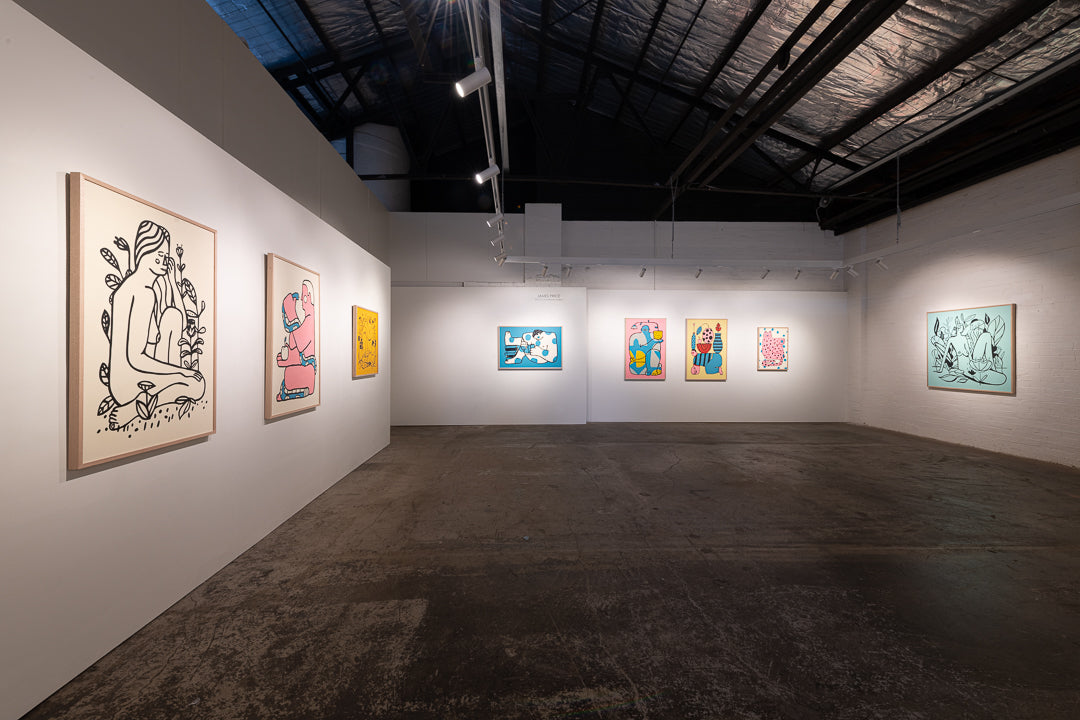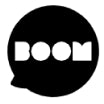
“These are works about life at it’s most calm. For me most things are at their most beautiful when they are still. When I stay still and try to think about love I think about the charm of people, and of nature. I’m trying to create work that carries this sort of charismatic energy – undeniably alive, and perfectly still.”
James Price is an internationally acclaimed artist and maker. He uses the term ‘maker’ as its lot easier than listing himself as a video artist, installation artist, illustrator, photographer, animation director, painter, art director, live action director, documentarian, poet, writer and storyteller. James has won lots of awards all over the world for his works. His drawings, films, writing, paintings, installations and photography mix elements of Folk art and contemporary Abstraction to help connect the dots between our history, our identity and our inner ‘primal’ self.
Whether telling his own story or helping other people tell theirs he strongly believes that communication works best when it comes directly from the imperfect heart of its creators. Following stints living and traveling all over the globe – including a decade working from his own highly successful studio in New York, James currently resides in Melbourne. He considers himself a citizen of the world (which is rubbish, because both his passport and his accent say he’s Australian). 
We asked James some questions about his art & life..

Being creative seems to be a huge part of what makes you, you. What were you like as a kid? Did the drive to make begin then? How did this inform your choices for a creative career?
I was a happy kid. I grew up in a house that was very supportive of me being whatever I wanted to be. I was really conflicted as a teenager as I was really into sport (I played footy for the Geelong Falcons), but I was also really into The Cure, and then punk music, and also trying to figure out my sexuality. I always felt like a bit of an outsider in all the worlds I inhabited.
I think feeling like an outsider drove me to spend time by myself developing my creative skills. Making things has become my way to connect with people.

Art and Design are best friends but can be quite distinct for the artists doing the work, (in terms of briefs, brand guidelines, budgets, client expectations and criticism etc). Can you talk a bit about being a designer and how the experience differs from your arts practice now?
Design is always much more about rationality and purpose. It’s never enough in the design world to explain to someone that you ‘just like it that way’. You have to be able to explain it through the prism of what the original objective is. A lot of that is about language, and inclusivity.
Art is about what the artists trying to say. To be honest I find art much more difficult to make. Not the actual process of physically painting or drawing or constructing the work, but the internal dialogue around ‘why’. Often I’ve made work and then questioned it because I was trying to figure out what my perspective was as an artist. ‘Whats my voice’, ‘Why does this work matter?’ – those are the sort of questions that have crippled me for about a decade.
I do love the interplay between Art and Design. Often a client wants me to do something and I learn a new technique that clarifies my art making process, and vice versa. Also, working with other people can be informative in terms of understanding humanity in a broader context. Seeing things from other peoples perspective and acting with empathy is it’s own art form, and design processes can illuminate some of that.

Tell me about Arthur Bannon..
My first few exhibitions at Boom I made under the pseudonym Arthur Bannon. I wanted to separate my design work from my art work. I think I felt they needed to be distinctly different. It was all about figuring out what my art was trying to say on it’s own, for it to be unencumbered from my design history. Arthur is my middle name, and Bannon is my mum’s maiden name. In hindsight I wished I called myself Rudolf Knuckleduster, or something equally flamboyant. If i’ve learnt anything from life it’s that if you’re going to have a pseudonym make it ridiculous.
In the end I killed Arthur off by merging him into me. I think so often we want people to accept us as multifaceted and multidimensional, but what we want in others is simplicity and consistency. I realised that it’s ok for me to do multiple creative things and for them to bleed into each other, and I trusted that people would embrace that.

Much of your recent work as an artist has been working in public or with community groups to create large scale projects. Accessibility, participation, engagement and fun are so important for all communities, now so more than ever in the current state of isolation we are all experiencing. How do you think these kinds of projects will play out in the future? Will the need for them outweigh the risks of large groups getting together?
I think the need for art in every community will always outweigh any concern. We have so many tools to interact, and they all have their own limitations and idiosyncrasies, but they allow us to create communities and connect. Art is particularly important for communities because it exists to emote. It’s so important that we document our emotions, if even just for catharsis – to get it out of us and move forward.

Talk me through a day in the studio.. I feel like you are quite prolific.. do you set yourself briefs or does it all just flow out of you?
My art making process is rooted in drawing. I have multiple sketchbooks on the go. I use drawing as an anti-anxiety medication. If I’ve had a bad day I draw for 30 minutes and it somehow wipes my mind clean.
I don’t set briefs for art making. I tend to let the drawings guide me. I usually draw, then create a rough smaller painting, then transfer that to the finished work. By the time I’m painting the final thing I’ve made the marks 3 times, so I know what makes them special, and how to keep the energy in them.
 You have a very identifiable ‘style’ even though I have seen your work evolve and change during the years I have been at Boom. You talk about leaning into a somewhat naïve approach that could be described as folk art. Is this something that comes naturally or is the designer in you conscious and critical of every mark made?
You have a very identifiable ‘style’ even though I have seen your work evolve and change during the years I have been at Boom. You talk about leaning into a somewhat naïve approach that could be described as folk art. Is this something that comes naturally or is the designer in you conscious and critical of every mark made?
It’s certainly not a conscious thought, so maybe it’s innate. I love deeply conceptual art – Theaster Gates, Elmgreen and Dragset, Martin Creed and Gabriel Orozco. I think thats what has made it so hard for me historically to reconcile my taste with what I make.
I try to make things that communicate a universality. I often paint people or animals. Things I understand, but I don’t understand at all. The style of the work is possibly born from an acceptance of all that – ‘You are complex, but I want you to be simple, but I know you aren’t, but I love you anyways’. I try and paint things from a place of empathy.

Your work for ‘The Sun Sat Still and Smiled’ looks at quiet, everyday moments – sitting, pondering, reading, just being. I really like your examination and representation of ‘the everyday’ (with some humour incorporated of course!). How did the concept for this exhibition come about?
Originally I was thinking a lot about what drawing and art making is to me, and how grateful I am to be able to make myself happy from my own actions. I think people who can be happy on their own have a magic about them.
So I made drawings about people doing that, and tried to create clarity in the compositions, and those became the paintings.
It also just seemed like the time to focus on the possibilities of being by ourselves. It’s one of the things we can control at the moment.

How are you surviving Stage 4 in Melbourne? This must be an incredibly difficult time…
I’m a very work centric person, and I work from home anyways, so it’s been productive. If you focus on what you can’t do you’ll go mad, so I’m doing a lot of drawing and thinking about the possibilities of where my work can go next.
Also, Negroni’s help.

The Sun Sat Still and Smiled runs until September 6. View it online here.

